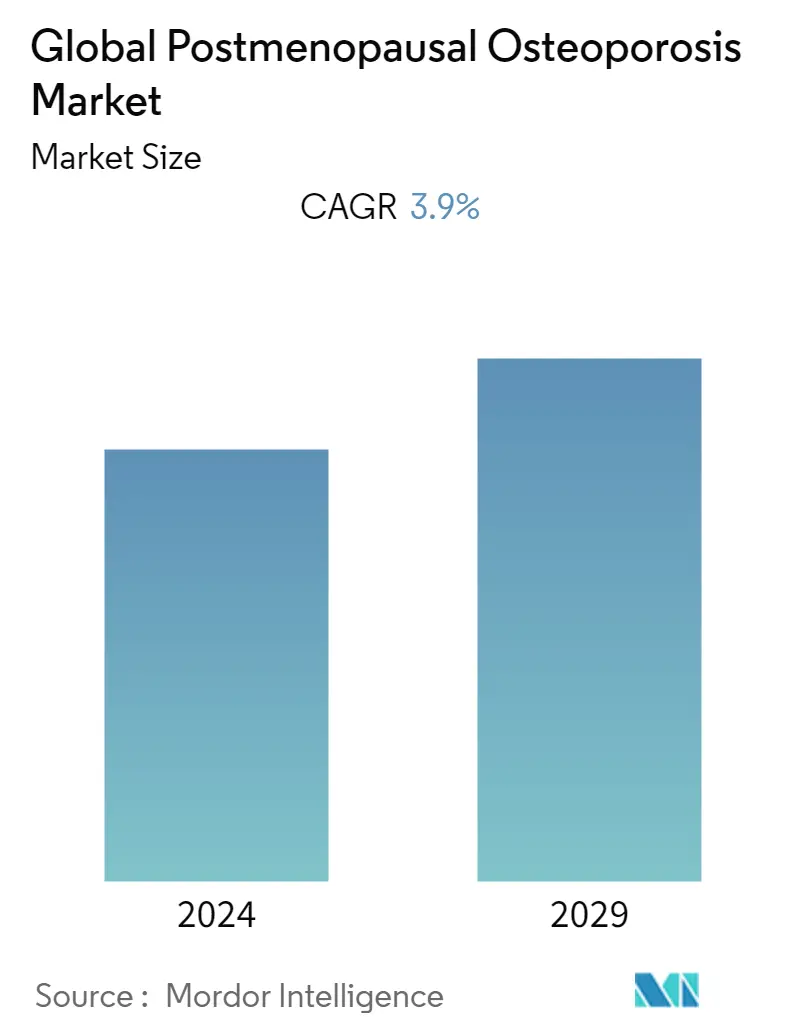Market Size of Global Postmenopausal Osteoporosis Industry

| Study Period | 2019 - 2029 |
| Base Year For Estimation | 2023 |
| CAGR | 3.90 % |
| Fastest Growing Market | Asia-Pacific |
| Largest Market | North America |
| Market Concentration | Medium |
Major Players
*Disclaimer: Major Players sorted in no particular order |
Postmenopausal Osteoporosis Market Analysis
The postmenopausal osteoporosis market is projected to register a CAGR of 3.9% during the forecast period of 2022-2027.
The outbreak of Covid-19 has significantly impacted the healthcare industry, including relative negligence of chronic diseases such as osteoporosis. A survey conducted by the National Osteoporosis Foundation and International Osteoporosis Foundation concluded that the major impact includes delays in scanning for diagnosis, interruptions in the supply of drugs and raw material, an increase in telemedicine consultations, and a decrease in parenteral medicine delivery. Further, according to a research study published in March 2021, titled 'Effects of COVID-19 Lockdown on Adherence to Individual Home- or Gym-Based Exercise Training among Women with Postmenopausal Osteoporosis', being at home can result in decreased physical activity and sedentary behavior, the COVID-19 epidemic and its constraints may have interfered with the study participants' schedules and motivation, and the reduction or lack of social bonds that are usually essential to encourage the elderly to exercise may have reduced. Hence, COVID-19 is expected to have a significant impact on the postmenopausal osteoporosis market, however, with the decreasing COVID-19 cases and large-scale vaccination programs, the studied market is expected to regain its full potential over the forecast period.
The aging population and lifestyle changes are the key factors responsible for the growth of the postmenopausal osteoporosis market as the older population is more prone to osteoporosis and thus increase in their population is expected to be a significant growth factor. For instance, according to the World Health Organization's October 2021 report, the population of people of age 60 years and more is expected to increase from 1 billion in 2020 to 1.4 billion by 2030 and 2.1 billion by 2050. Hence, the market is projected to grow during the forecast period with an increase in demand for therapy of postmenopausal osteoporosis in the older population.
Additionally, lifestyle changes such as lack of exercise, high consumption of alcohol or smoking, prolonged work duration, and unhealthy eating habits also impact the menopausal period and lead to osteoporosis in many women worldwide. Age, smoking, alcohol, and consumption of medications used to treat various diseases such as gonadotropins, excess consumption of thyroid hormone, and cytotoxic agents are some of the risk factors for causing low bone density and thereby developing osteoporosis after menopause in women. According to data published by the International Menopause Society (IMS), in 2021, more than 200 million women are estimated to suffer from osteoporosis, and 1 in 3 women aged more than 50 is expected to experience osteoporosis fracture. Therefore, due to the aforementioned factors, the studied market is expected to grow over the forecast period. However, low awareness about postmenopausal osteoporosis is expected to restrain the growth of the studied market during the forecast period.
Postmenopausal Osteoporosis Industry Segmentation
As per the scope of the report, when women go through a transitional menopausal period, more bone resorption happen than formation due to a drop in estrogen level, resulting in osteoporosis. Therapy or treatment for this condition is considered in the report's scope. The postmenopausal osteoporosis market is segmented by treatment (vitamin D, bisphosphonates, hormone replacement therapy, parathyroid hormone therapy, and others), distribution channel (hospital pharmacies, retail pharmacies, and online pharmacies), and geography (North America, Europe, Asia-Pacific, Middle East and Africa, and South America). The market report also covers the estimated market sizes and trends for 17 different countries across major regions globally. The report offers the value (in USD million) for the above segments.
| By Treatment | |
| Vitamin D | |
| Bisphosphonates | |
| Hormone Replacement Therapy | |
| Parathyroid Hormone Therapy | |
| Others |
| By Distribution Channel | |
| Hospital Pharmacies | |
| Retail Pharmacies | |
| Online Pharmacies |
| Geography | ||||||||
| ||||||||
| ||||||||
| ||||||||
| ||||||||
|
Global Postmenopausal Osteoporosis Market Size Summary
The postmenopausal osteoporosis market is anticipated to experience steady growth over the forecast period, driven by an aging population and lifestyle changes that increase the risk of osteoporosis among women. The market's expansion is supported by the rising prevalence of osteoporosis due to factors such as sedentary lifestyles, unhealthy eating habits, and the consumption of substances like alcohol and tobacco. Despite the challenges posed by the COVID-19 pandemic, which disrupted diagnosis and treatment processes, the market is expected to recover as vaccination efforts progress and healthcare systems stabilize. The demand for effective therapies, particularly bisphosphonates, which are widely prescribed to prevent bone density loss and reduce fracture risk, is expected to contribute significantly to market growth.
North America is projected to lead the market, bolstered by its advanced healthcare infrastructure, high diagnosis and treatment rates, and substantial research and development activities. The presence of major industry players and a large patient base further enhances the region's market position. The competitive landscape is characterized by the presence of numerous generics, with key players like Novartis International AG, Eli Lilly and Co., and Pfizer Inc. actively engaging in strategies to expand their market share. Initiatives to increase awareness and develop new treatments, along with collaborations to enhance drug accessibility, are pivotal in shaping the market dynamics. The introduction of new therapies, such as Chugai Pharma's Edirol in China, and regional efforts to standardize osteoporosis management practices are expected to further stimulate market growth, particularly in the Asia-Pacific region.
Global Postmenopausal Osteoporosis Market Size - Table of Contents
-
1. MARKET DYNAMICS
-
1.1 Market Overview
-
1.2 Market Drivers
-
1.2.1 Increase in Geriatric Population
-
1.2.2 Investment by Market Players and Thereby Strong Pipeline
-
-
1.3 Market Restraints
-
1.3.1 Low Awarenss about Postmenopause Osteoporosis
-
-
1.4 Porter's Five Forces Analysis
-
1.4.1 Threat of New Entrants
-
1.4.2 Bargaining Power of Buyers/Consumers
-
1.4.3 Bargaining Power of Suppliers
-
1.4.4 Threat of Substitute Products
-
1.4.5 Intensity of Competitive Rivalry
-
-
-
2. MARKET SEGMENTATION
-
2.1 By Treatment
-
2.1.1 Vitamin D
-
2.1.2 Bisphosphonates
-
2.1.3 Hormone Replacement Therapy
-
2.1.4 Parathyroid Hormone Therapy
-
2.1.5 Others
-
-
2.2 By Distribution Channel
-
2.2.1 Hospital Pharmacies
-
2.2.2 Retail Pharmacies
-
2.2.3 Online Pharmacies
-
-
2.3 Geography
-
2.3.1 North America
-
2.3.1.1 United States
-
2.3.1.2 Canada
-
2.3.1.3 Mexico
-
-
2.3.2 Europe
-
2.3.2.1 Germany
-
2.3.2.2 United Kingdom
-
2.3.2.3 France
-
2.3.2.4 Italy
-
2.3.2.5 Spain
-
2.3.2.6 Rest of Europe
-
-
2.3.3 Asia-Pacific
-
2.3.3.1 China
-
2.3.3.2 Japan
-
2.3.3.3 India
-
2.3.3.4 Australia
-
2.3.3.5 South Korea
-
2.3.3.6 Rest of Asia-Pacific
-
-
2.3.4 Middle East and Africa
-
2.3.4.1 GCC
-
2.3.4.2 South Africa
-
2.3.4.3 Rest of Middle East and Africa
-
-
2.3.5 South America
-
2.3.5.1 Brazil
-
2.3.5.2 Argentina
-
2.3.5.3 Rest of South America
-
-
-
Global Postmenopausal Osteoporosis Market Size FAQs
What is the current Global Postmenopausal Osteoporosis Market size?
The Global Postmenopausal Osteoporosis Market is projected to register a CAGR of 3.9% during the forecast period (2024-2029)
Who are the key players in Global Postmenopausal Osteoporosis Market?
Amgen Inc. , Eli Lilly and Co. , F. Hoffmann-La Roche Ltd , Merck & Co., Inc. and Allergan plc are the major companies operating in the Global Postmenopausal Osteoporosis Market.

